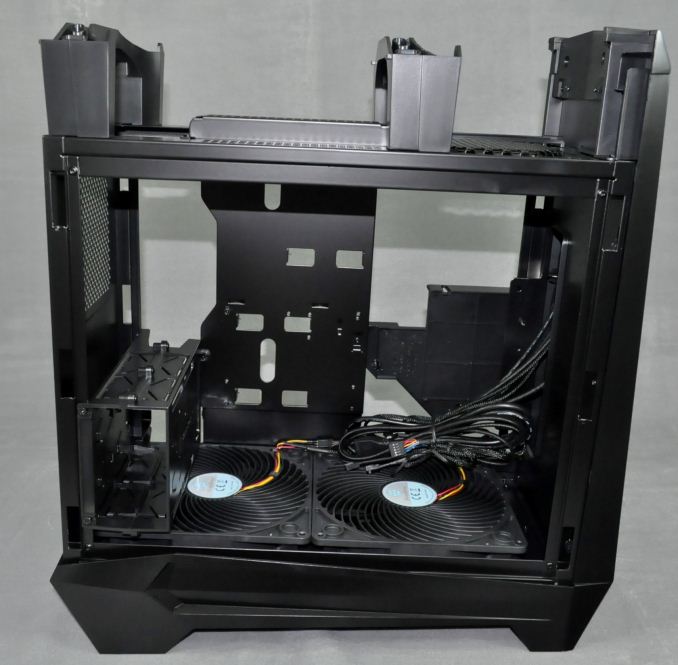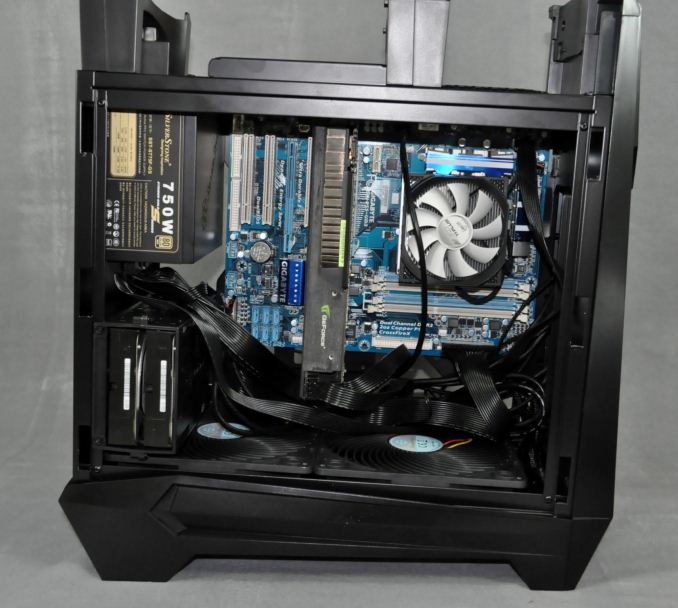SilverStone Raven RV05 Case Review
by E. Fylladitakis on December 24, 2014 10:00 AM EST- Posted in
- Cases/Cooling/PSUs
- SilverStone
- Case
SilverStone Raven RV05 Interior
Once the side panels are off, the miniscule dimensions of the Raven RV05 become apparent. The system area is much smaller than one would originally assume by the external dimensions of the case, as a large area at the top of the case is reserved for routing the device and power cables, and tall feet elevate it so the fans to have a clear intake, leaving a space hardly larger than the motherboard tray itself.
Inside, the case has its motherboard tray rotated by about 100°, facing up and slightly tilted towards the front of the case. There are few supports and only half of the motherboard tray remains, but the small size of the case grants it admirable mechanical cohesion considering the materials used. Everything in and around the Raven RV05 is black, including the fans, plastic, supports, screws, cables, etc.
When the side panels are removed, the plastic braces at the top of the case that support the top and side panels can be used as handles. They are sturdy enough to hold the weight of the case and the system with ease, so the user does not have to fear about picking up and moving the case using them. For the installation of components, such as the PSU, a medium-long shank screwdriver is necessary, as some of the screws are only accessible through the holes in these plastic braces.
The PSU compartment is at the upper rear side of the case, and the PSU is installed with its exhaust facing upwards. There is room for a PSU up to 170mm long, which limits the choices for enthusiasts that want a powerful unit. SilverStone provided us with one of their Strider Gold 750W units for this article that, according to the company, is the world's smallest modular PSU. We can certainly see how that is useful, as the 750W unit still barely fits in the compartment. If 3.5" drives are unnecessary, the plastic cage can be removed and then PSUs of virtually any length can be installed. Nevertheless, we strongly recommend against the installation of a long PSU, as the fan of the PSU will not be in alignment with the intake opening of the case.
Two massive 180mm "Penetrator" SST-AP181-H fans are preinstalled at the bottom of the Raven RV05. Each of these fans can move up to 130CFM – a ludicrous volume of air for 1200RPM fans. They are not really quiet at maximum speed but the Raven RV05 has basic fan speed switches installed. The dense plastic guard is very practical, as the many cables that will be going around that area would surely cause problems. If you want to install a watercooling radiator, these fans can be removed and a dual 240mm/280mm radiator can be installed. A smaller radiator (up to 120mm and thin) could fit at the smaller opening at the top of the case, but the proximity of the motherboard can create compatibility issues.
As for the drives, the Raven RV05 offers somewhat limited storage expansion options. The user can only install two 3.5" drives in the modular bay below the PSU compartment. Two 3.5" should suffice for most home users, so we have no real complaints here, though a typical ATX case can easily hold at least four. There are two additional slots for 2.5" drives, behind the motherboard tray. This peculiar position is not very practical and it makes the routing of cables a nightmare, as there is no room or clearance for routing the cables of the system, or even of the drives themselves. Finally, as we also mentioned in the previous page, there is no support for 5.25" devices at all. There is only support for a slim, slot-loading drive, the tray of which needs to be removed if you are trying to install a CPU cooler with the motherboard inside the case.
As exhibited in the pictures of our test build, the interior of the Raven RV05 can end up looking rather messy, even with just one GPU installed. There are simply no pathways for routing the cables, the bulk of which will amass at the bottom of the case, between the motherboard and the intake fans. Graphics cards longer than 310mm cannot fit and that rules out a few performance behemoths and dual GPU implementations.
Routing the cables from the rear of the motherboard tray is not really practical, as there is very little space when a 2.5" drive has been installed. There is also the possibility of damaged cables from the sharp edges of the motherboard tray, so bundling the cables and then pressing the side panel hard until it closes is not a particularly wise idea. Overall, it's not too difficult to assemble a system in the RV05, but the compact design doesn't really lend itself towards a clean looking interior; the non-windows case might be a better option for users that don't want to spend a lot of time cleaning up the interior cabling.


















29 Comments
View All Comments
Blaid - Wednesday, December 24, 2014 - link
Thanks for posting a review of a unique case on Christmas Eve. A nice read for those of us sitting at help desks nation wide.Tikcus9666 - Wednesday, December 24, 2014 - link
+1Flunk - Wednesday, December 24, 2014 - link
That's rough, I used to have to do that. Take heart, at some point you'll not be the entry-level help desk guy any more and you won't have to work Christmas Eve.gopher1369 - Thursday, December 25, 2014 - link
I personally can't wait until I'm 3rd line support and am on call 24/7 including Christmas Day, that will be a huge improvement!lavaheadache - Wednesday, December 24, 2014 - link
gotta love that you used a GTX 295 in the build. An oldie but a goodieromrunning - Wednesday, December 24, 2014 - link
"With the exception of the RV04, which does not share the 90° design, the cases of the Raven series were somewhat bulky and excessively long – features that did not make them very popular among users."The RVZ01 Raven is a mini-ITX case - perhaps you can review that one as it definitely isn't bulky or excessively long.
wiz329 - Wednesday, December 24, 2014 - link
Glad to see a new case review, it's been awhile!lorribot - Wednesday, December 24, 2014 - link
Bottom up cooling is a sensible way to go, however current motherboard ATX and mATX siz and shape limits things, ITX would be a better way to go but you are limited by number of graphics cards they extra cost of the MoBos themselves (why do we still pay more for less?), perhaps this is why Apple design their own MoBos and why they can do things like the the Mac Pro.SHuttle used to do thier own MoBos in their cases, I am sure they would be a market for an inovative case manufacturer or boutique PC company (or even Alienware with Dell backing) to come up with a truly unique design with a nonstandard mobo.
Or a mobo manufacturer to come up with split MoBo (say CPU/RAM and PCI-x/SATA/USB) that could be used in more inovative case designs.
It just needs someone with some vision and who can think out of the box.
JarredWalton - Wednesday, December 24, 2014 - link
Sadly, long-term reliability of Shuttle cases was highly suspect in my experience. I reviewed probably a dozen or so of their SFFs in the 2004-2006 time frame, and nearly every one ended up dead within two years. Which isn't to say other companies were better with those early proprietary SFFs -- I think every option basically was questionable. Biostar, MSI, Shuttle, Foxconn... they all often failed within a year or two (sometimes even less). That was the problem with CPUs using so much power, and we've improved a lot since then plus manufacturing tends to be better. What's crazy is that our modern ITX designs aren't really any less expensive than the old proprietary stuff. :'(Zimeon - Wednesday, December 24, 2014 - link
What the hell is that coca-cola can doing in the picture? *sigh* But nice case review none the less.